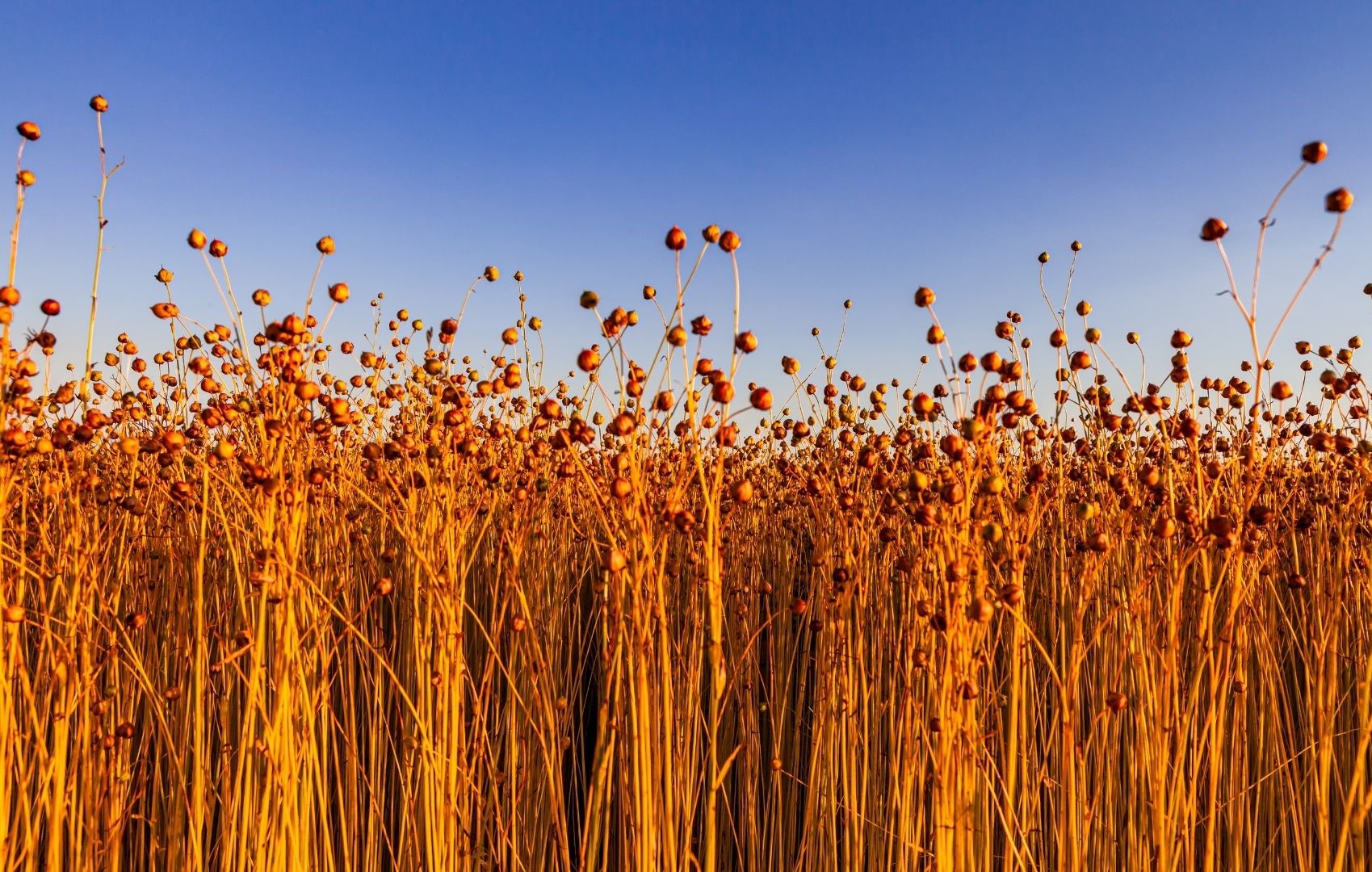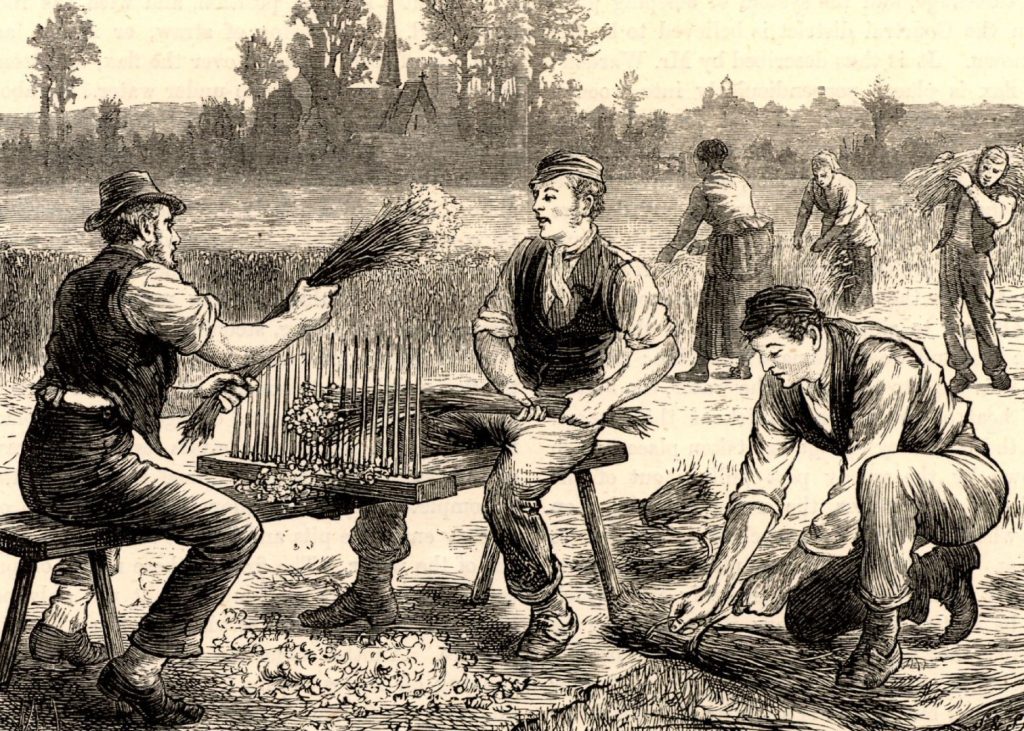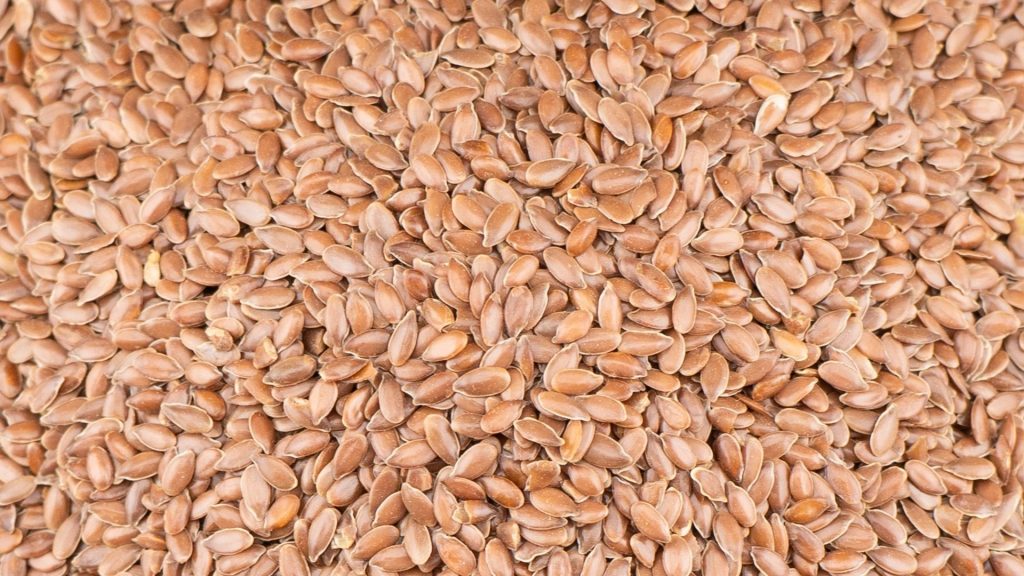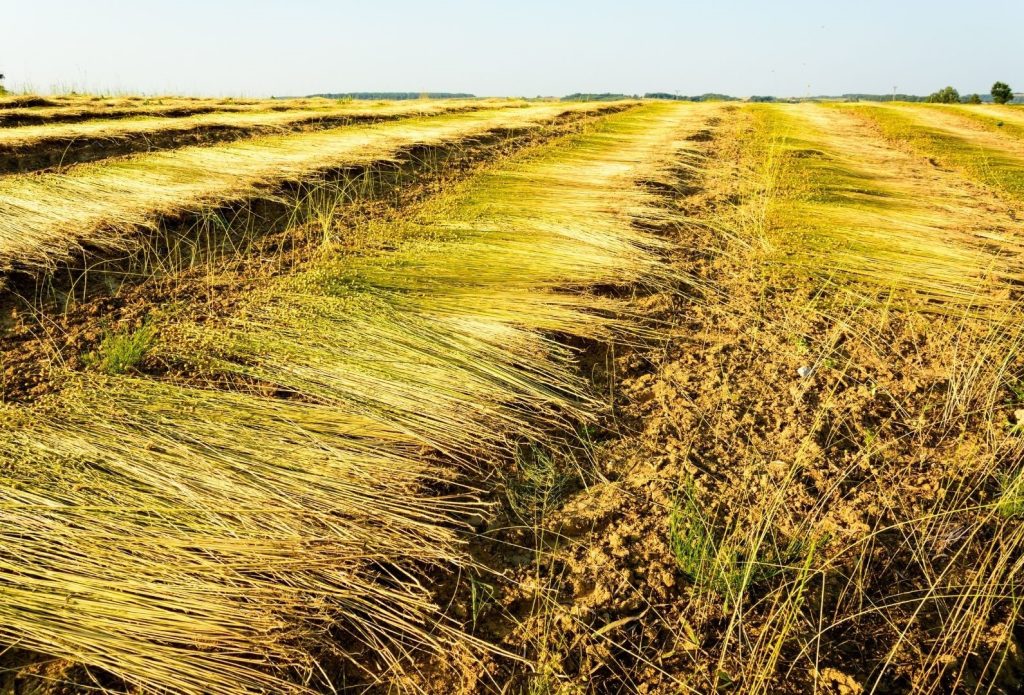A Complete Guide on Flaxseed Cultivation

This post is also available in:
This post is also available in:
![]() العربية (Arabic)
العربية (Arabic)
Complete Flax Cultivation Guide – How to grow flax (linseed) for profit
Flax: Origin and history
Flax (Linum usitatissimum L) is one of the oldest crops and has been cultivated for more than 5,000 years in the southern part of Asia and the Mediterranean region. For this reason, its cultivation has been known since ancient times in Iraq, Egypt, Turkey, and Syria; it has been cultivated from Asia to Europe and then America.
The cultivation of flax has been going back since the time of the Pharaohs, and this has been proven through many inscriptions and papyri, which revealed their ingenuity in using it in many areas of daily life, to the point that they included it in the mechanisms and means of mummification.
Vavilov, the famous plant scientist, believes that the flax originated from the regions of Afghanistan and Uzbekistan, India, and the Mediterranean (in Spain, Greater Asia, and Egypt) and has been domesticated in the Fertile Crescent. The flax currently grown commercially seems to be the product of natural hybridizations between 2-3 flax plant varieties. The wild relative of flax is Linum angustifolium (wild flax), which is native to the Mediterranean.

Flax description – Flax plant information
Flax is a cool-season plant that belongs to the Linaceae family and the genus Linum, and the modern varieties/types are annual plants. Depending on the type, flax plants can grow in a wide variety of climates and are considered resilient plants. Flax for linseed cultivation grows best in warm, subtropical regions and highlands, while fiber flax is mainly grown in temperate climates with relatively low temperatures and high air humidity.
Flax is a crop with a relatively long cultivation period, reaching up to 100 days. The seeds are mature and ready to be harvested approximately 30 days after flowering.
Fiber flax grows a long, unbranched main stem and is taller than the linseed type, reaching 1.5 m. On the other hand, linseed (oil flax) is much shorter (half a meter in height or a little more), with many branches. Its flowers are blue, white, or purple, and its fruit is a canopy containing flax seeds.

Flaxseed oil composition
Like other edible oils, the main component of flaxseed oil is fatty acid. Other compounds in flaxseed oil, such as volatile compounds, phenolic compounds, tocopherol, phytosterols, etc., have been detected. Flaxseed oil contains around 96% triacylglycerides (TAG) and 1.4% polar lipids, glycol, and phospholipids. The main TAG in flaxseed oil is trilinoleate (35%). Also found that fatty acids of flaxseed oils were mainly composed of linolenic acid (53.36–65.84%), linoleic acid (10.14–16.39%), oleic acid (10.03–12.37%), stearic acid (3.98–9.85%) and palmitic acid (2.41–7.97%), respectively.
Economic uses and benefits of flax
This plant has many benefits, as every part of it can be exploited to produce seeds, oil, and fiber.
The fibers extracted from it are used in many industries, depending on its type, degree of softness, and length. Therefore, it can be used for the production of textiles and fabrics (the production of linen yarn), paper, pressurized wooden bricks, and in wood-finishing products.
On the other hand, the seeds can be used as a whole as part of the human diet, offering many health benefits thanks to the Omega 3, α-linolenic acid (ALA) (fatty acid), lignans, proteins (18–23%), and dietary fibers they contain. For this reason, the seeds have been used to help patients with diabetes, cholesterol, and heart problems; at the same time, the oil extracted from the linseeds (30 to 44% oil content) contains high amounts of α-linolenic acid (ALA) and other substances that make it nutritious and with anti-inflammatory effects (it also help in healthy bowel movement). Food products based on flaxseed oil, such as bread, cookies, drinks, ice cream, salad dressings, sausages, egg sticks, yogurts, fat spreads, surimi, cheese, etc. Also, after extracting the oils from the seeds, the residue is used in the feed industry, which is one of the main pillars on which animal production projects are based.
Classification of types of Flax
- Fibrous flax type:
- Oil produced Flax type (linseed)
- Dual-purpose Flax
Flax cultivation:
The flax crop is usually grown after cotton, corn, summer leguminous crops such as soybeans, or oil crops such as sunflowers. It is not planted after rice due to the difficulty of smoothing the seed beds. Aster flax, the farmer can sow corn, rice, or peanuts.
Growing flax in light clay or heavy yellow soils of homogeneous fertility is preferable. Planting flax should be avoided in lands with high salinity levels or fields with high weed pressure. It is also recommended not to plant flax in the same site/field consecutively for more than 2-3 years.
Seeds:
The seeds should be fully mature, plump (well-filled), not atrophied, uniform in size, pure in variety, disease-free, and free of foreign seeds to produce a highly homogeneous crop.
As for seeds mixed with different varieties or with weed seeds, they should not be used at all because any other variety with the flax crop reduces its value in the market.
Planting time:
Flax is a winter crop that requires low temperatures to grow. Newly emerged seedlings (cotyledon stage) can tolerate temperatures down to -2 to -4 °C (25 to 28 °F). Plants at the two-leaf stage can tolerate up to -5.5 to -8 °C (18 to 22 °F). Flax grows well at 13 to 20 °C temperatures and faster than grasses at lower temperatures.
Planting methods
1. Scattering – Broadcast seeding
The seeds are scattered in the ground in two perpendicular directions to ensure uniform distribution. This method of planting can be used in regions where land leveling is challenging and can follow rainfall or irrigation (sowing when the soil is still wet).
2. Use of seeders (mechanical sowing) – Seed drill
The use of row seeders in flax cultivation is the ideal, modern method to ensure that the seeds are well distributed in the field and at fixed distances of 7.5-20 cm (drill spacing). For no-till systems, a row distance of 30 cm can be chosen. In dry years or in fields with high weed pressure, farmers may choose a 70-90 cm row planting distance. This provides good plant growth and produces robust plants (of desirable thickness and strong stems). The thickness of the stem ranges from 1.5 – 3.0 cm. It meets the manufacturer’s desire to obtain high-quality fiber to produce a fine yarn.
Seed rate – Planting distances for Flax
1. In clay soils: Using a seed rate of 40-60 kg/hectare when planting using row seeders and 70 kg when planting using the scattering seed method is recommended for local dual-purpose varieties. As for fiber-flax varieties, it is recommended to use a seed rate of 40 and 45 kg in the case of planting in rows or broadcasting, respectively.
2. In sandy soils: Flax is sown at a lower seed rate due to the high germination rate flax has in such soils because there are no barriers compared to clay soils. Flax plants growing in sandy fields are characterized by the high quality of fibers produced per unit area due to their lack of organic and humic matter.
Irrigated fields may support a higher seeding rate. In late sowing, it is also important to use higher seed rates. Generally, shallow sowing is preferred (2.5-4 cm deep).
Irrigation of Flax – Water needs of flax
The irrigation process (planting irrigation) must be done slowly in the broadcasting planting to reduce the seeds drifting and gathering in low places due to water flow, negatively affecting seed distribution, crop emergence, and homogeneity. However, in the case of mechanical row planting, the irrigation process can be carried out after the completion of sowing.
Surface irrigation is used in clay lands, while sprinkler or center-pivot irrigation methods are preferred in light soils.
1- Irrigation in clay soils
Flax needs 5-6 irrigations in clay soils during the growing season. The period between one irrigation and the next ranges from 20-25 days and may be longer than that in the event of heavy rain. It should also be taken into account that the irrigation during planting should be slow (avoid high pressure that will create a strong flow and soil disturbance) so that there is no drifting of the seeds, especially in the case of broadcasting planting. It is also necessary to be careful with the irrigation timing and avoid applying it in windy weather (important for overhead irrigation) during the seed growth stage to decrease the risk of occurrence of lodging and the accompanying increase in the percentage of unfilled capsules. It also affects the quality of the fibers and, thus, causes a decrease in the quantity and quality of the crop.
Plants must not experience drought stress to obtain a high seed yield. Watering should be suspended two weeks before harvest.
2- Irrigation in new light soils
In the case of sprinkler irrigation, it is recommended that the irrigation process be carried out every 3-4 days, depending on the type of soil and the weather conditions, due to the difficulty of these soils retaining water for a long time. Also, prolonging the irrigation period for more than a week leads to stunting of the plants and a decrease in straw and seed yields.

Flax Fertilization – Nutrient needs of Flax
1- In clay soils
Phosphate fertilizer is added to flax during service operations at a rate of 100 kg (single superphosphate or triple superphosphate). Flax also responds well to nitrogen fertilization in the range of 45-55 nitrogen units, depending on soil fertility and the previous crop, to obtain a high yield of straw, seeds, and high-quality fiber. Excessive nitrogen fertilization also leads to plant lodging and a decrease in the quantity and quality of the crop. Nitrogen fertilizer is added with broadcasting in three equal batches (the first before the initial irrigation – the second before the second irrigation – and the third before the third irrigation), provided that the fertilizer is added at the end of the day immediately preceding irrigation so that a portion of the nitrogen is not lost through volatilization, decreasing the environmental pollution due to runoff and nutrient leakage. In the case of good vegetative growth of flax plants, the third batch of nitrogen fertilizer may not be added to avoid lodging, which can result in crop yield and quality reduction.
2- In the light/sandy soils
Flax needs higher rates of phosphate fertilizer in light soils than in clay. More specifically, 150 kg of single superphosphate fertilizer or the equivalent triple fertilizers are needed per acre. Flax also needs 50 kg/acre, as potassium sulfate (48% before the last plowing, before planting, 75 units of nitrogen from ammonium sulfate 20.5% or ammonium nitrate 23.5%).
Urea fertilizers are best to be avoided as a nitrogen source for flax crops. In the case of sprinkler irrigation, nitrogen fertilizer is added in 5 equal batches: the first batch before planting to stimulate sprouting and the last batch about 60 days after planting.
In the case of flood irrigation in sandy soils, the nitrogen fertilizer is added in four equal batches, provided that fertilization is done every 15 days and immediately before irrigation. A soil analysis should be performed before planning the fertilization program.
Weed control in flax fields
Flax plants could “suffer” from broad-leaf and narrow-leaf annual winter weeds. The manual tillage of flax weeds must be carried out in the early stages of growth if they are few so as not to cause mechanical damage to the plant. If the weeds are dense, they must be controlled using herbicides. The best time for chemical control is when the length of the plants is between 12 and 15 cm at most and there is moderate soil moisture to avoid damaging the flax plants or reducing the efficiency of the pesticides. Farmers are advised to read the product label carefully and consult a licensed local agronomist.
Major Fungal diseases of flax and their management
1. Flax seedling blight and root rot: It leads to failure of seed germination or the seedling’s death as soon as they appear on the soil’s surface. To manage this disease, it is recommended to use healthy seeds.
2. Powdery mildew: A common first symptom of the disease is the formation of small white spots on the underside of the leaves. Then, these spots merge and increase in area until they spread to all parts of the vegetative system. It is recommended to avoid infection by planting early, moderating irrigation, avoiding excessive nitrogen fertilization, taking care of phosphate fertilization, and using recommended pesticides.
3. Flax rust: The infection appears in the form of orange pustules on the underside of the leaves and then appears on the upper side, too. Seed capsules and stems can be infected. At the end of the season, the color of the pustules turns brown. It is recommended to plant resistant varieties.
Other diseases such as wilt, stem mold and rot, and brown stem blight can occur in a flax crop.
The most common flax insect pests and their management
1. Aphids: The infestation appears in the middle of the plant’s life and increases at the edges of the field and in areas with weeds. It is recommended to pay attention to weed control and balanced nutrition of the plants (avoid nitrogen overfertilization).
2. The flax fruit worm (the nematode bug): The green-colored larvae feed on the flax seeds inside the capsules until the fruits are empty/hollow. It is recommended to remove weeds and not delay planting after mid-November.

When and how to harvest flax
It is recommended to harvest flax when the color of the capsule turns pale yellow, regardless of the color of the stems or the leaf’s senescence. The harvesting process must take place early in the morning. Flax is usually harvested according to the planting date and the variety grown.
Harvesting is done manually or mechanically by taking a group of plants, wrapping them, and removing them from the ground. Then, the stems are placed on the ground so the roots are in one direction and the fruits are in the other. Then, the plants are left for two or three days; then, they are turned over to the other side to ensure that the stems, which take on a yellow color, are completely dried.
Then, the tying process is carried out by creating bundles with a diameter of 15 cm each in the area of the lower one-third of the stem. They are transported to the warehouse, and the bundles are then placed in piles with the capsule facing up to expose it to the sun, making it easier to separate the seeds from the capsules. It is also possible to harvest using harvesting machines, which saves time and reduces production costs.

References
https://edepot.wur.nl/22222#:~:text=bienne%20as%20the%20progenitor%20of,Zeven%20and%20de%20Wet%201975)
https://northerngraingrowers.org/wp-content/uploads/FLAX.pdf
https://qascf.com/index.php/qas/article/view/783/790
https://ccag.tamu.edu/wp-content/uploads/sites/10/2020/12/Keys-to-Profitable-Flax-Production.pdf










































































